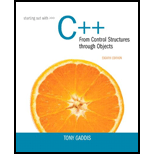
Concept explainers
NumDays Class
Design a class called NumDays. The class’s purpose is to store a value that represents a number of work hours and convert it to a number of days. For example, 8 hours would be converted to 1 day, 12 hours would be converted to 1.5 days, and 18 hours would be converted to 2.25 days. The class should have a constructor that accepts a number of hours, as well as member functions for storing and retrieving the hours and days. The class should also have the following overloaded operators:
+ Addition operator. When two NumDays objects are added together, the over loaded + operator should return the sum of the two objects’ hours members.
− Subtraction operator. When one NumDays object is subtracted from another, the overloaded - operator should return the difference of the two objects’ hours members.
++ Prefix and postfix increment operators. These operators should increment the number of hours stored in the object. When incremented, the number of days should be automatically recalculated.
−− Prefix and postfix decrement operators. These operators should decrement the number of hours stored in the object. When decremented, the number of days should be automatically recalculated.
Want to see the full answer?
Check out a sample textbook solution
Chapter 14 Solutions
Starting Out with C++ from Control Structures to Objects (8th Edition)
Additional Engineering Textbook Solutions
Java How to Program, Early Objects (11th Edition) (Deitel: How to Program)
Starting Out with C++: Early Objects (9th Edition)
Problem Solving with C++ (10th Edition)
Electric Circuits. (11th Edition)
Starting Out with Java: From Control Structures through Objects (7th Edition) (What's New in Computer Science)
- Solve thisarrow_forwardSpecifications: Part-1Part-1: DescriptionIn this part of the lab you will build a single operation ALU. This ALU will implement a bitwise left rotation. Forthis lab assignment you are not allowed to use Digital's Arithmetic components.IF YOU ARE FOUND USING THEM, YOU WILL RECEIVE A ZERO FOR LAB2!The ALU you will be implementing consists of two 4-bit inputs (named inA and inB) and one 4-bit output (named out). Your ALU must rotate the bits in inA by the amount given by inB (i.e. 0-15).Part-1: User InterfaceYou are provided an interface file lab2_part1.dig; start Part-1 from this file.NOTE: You are not permitted to edit the content inside the dotted lines rectangle.Part-1: ExampleIn the figure above, the input values that we have selected to test are inA = {inA_3, inA_2, inA_1, inA_0} = {0, 1, 0,0} and inB = {inB_3, inB_2, inB_1, inB_0} = {0, 0, 1, 0}. Therefore, we must rotate the bus 0100 bitwise left by00102, or 2 in base 10, to get {0, 0, 0, 1}. Please note that a rotation left is…arrow_forwardHow can I perform Laplace Transformation when using integration based on this? Where we convert time-based domain to frequency domainarrow_forward
- what would be the best way I can explain the bevhoirs of Laplace and Inverse Transofrmation In MATLAB.arrow_forwardWhat IETF protocol is NetFlow associated with? Group of answer choices IPX/SPX IPIX HTTPS SSHarrow_forwardHow can I perform Laplace Transformation when using integration based on this?arrow_forward
- Write an example of a personal reflection of your course. - What you liked about the course. - What you didn’t like about the course. - Suggestions for improvement. Course: Information and Decision Sciences (IDS) The Reflection Paper should be 1 or 2 pages in length.arrow_forwardHow can I perform Laplace Transformation when using integration ?arrow_forwardUsing R languagearrow_forward
 EBK JAVA PROGRAMMINGComputer ScienceISBN:9781337671385Author:FARRELLPublisher:CENGAGE LEARNING - CONSIGNMENT
EBK JAVA PROGRAMMINGComputer ScienceISBN:9781337671385Author:FARRELLPublisher:CENGAGE LEARNING - CONSIGNMENT Microsoft Visual C#Computer ScienceISBN:9781337102100Author:Joyce, Farrell.Publisher:Cengage Learning,
Microsoft Visual C#Computer ScienceISBN:9781337102100Author:Joyce, Farrell.Publisher:Cengage Learning, Systems ArchitectureComputer ScienceISBN:9781305080195Author:Stephen D. BurdPublisher:Cengage Learning
Systems ArchitectureComputer ScienceISBN:9781305080195Author:Stephen D. BurdPublisher:Cengage Learning- Programming Logic & Design ComprehensiveComputer ScienceISBN:9781337669405Author:FARRELLPublisher:Cengage
 C++ for Engineers and ScientistsComputer ScienceISBN:9781133187844Author:Bronson, Gary J.Publisher:Course Technology Ptr
C++ for Engineers and ScientistsComputer ScienceISBN:9781133187844Author:Bronson, Gary J.Publisher:Course Technology Ptr C++ Programming: From Problem Analysis to Program...Computer ScienceISBN:9781337102087Author:D. S. MalikPublisher:Cengage Learning
C++ Programming: From Problem Analysis to Program...Computer ScienceISBN:9781337102087Author:D. S. MalikPublisher:Cengage Learning





